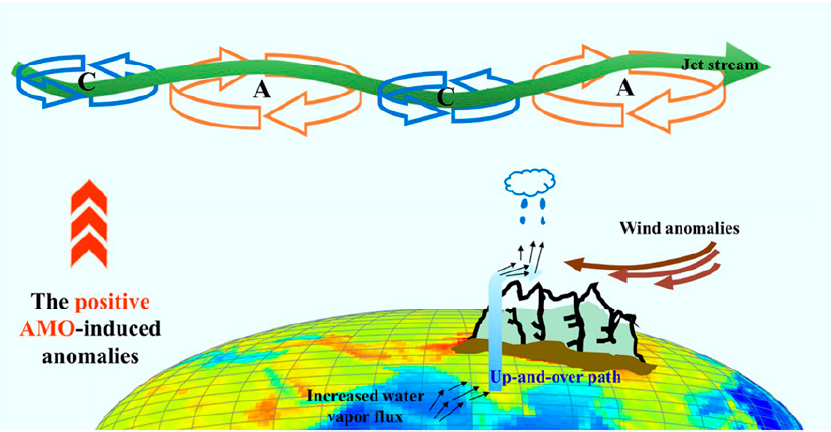On August 31, 2020, Professor Yang Kun's research group from the Department of Earth System Science (DESS) of Tsinghua University published a research paper titled Why Has the Inner Tibetan Plateau Become Wetter since the Mid-1990s? in the Journal of Climate, a high-impact geoscience journal, revealing since the mid-1990s in the 20th century, the internal flow area of the Qinghai-Tibet Plateau (the Qiangtang Plateau) has generally become wet while the eastern part of the Qinghai-Tibet Plateau has become less obvious.
The Qinghai-Tibet Plateau is known as the Asian Water Tower. Since the mid-1990s, its internal lakes have expanded dramatically, and most of these lakes are located in the Qiangtang Plateau. Studies have found that although the increase in glacial melt water has contributed to the expansion of lakes in the Qiangtang Plateau, the increase in precipitation in the past 20 years is the main cause of lake expansion. However, it is still unclear what caused the increase in precipitation in this area.

Figure 1 Since the mid-1990s, the internal lakes of the Qiangtang Plateau have expanded dramatically. Among them, picture a is provided by Dr. Yanbin Lei from the Institute of Tibetan Plateau Research, Chinese Academy of Sciences, and picture b is from Zhang et al., (2017, GRL).
Based on the above background, this study analyzed the characteristics of atmospheric circulation and water vapor changes related to the humidification process of the Qiangtang Plateau from 1979 to 2018. The results of the study indicate that this wetness process corresponds to the weakening of the westerly wind over the Qinghai-Tibet Plateau, which is regulated by the North Atlantic Multidecadal Oscillation (AMO) on an interdecadal scale. Since the mid-1990s, AMO has been in a warm phase (that is, abnormal warming of the North Atlantic surface), which has induced a series of cyclone and anticyclone anomalies transmitted along the Eurasian subtropical westerly jet, leading to the subtropical jet anomaly near the Tibetan Plateau Move north and/or weaken. The specific process is shown in Figure 2. It can be seen from Figure 2 that there is an abnormal anticyclone on the east side of the Qiangtang Plateau and an abnormal cyclone on the west side. The former weakens the westerly wind, which prevents the water vapor carried by the westerly wind from being transported further eastward, thus accumulating over the Qiangtang Plateau; the latter strengthens the southwest wind on the south side of the Qiangtang Plateau, which is beneficial for the water vapor from the Arabian Sea to enter the Qiangtang Plateau. Therefore, the above-mentioned favorable power and water vapor conditions have jointly enhanced the convergence of water vapor over the Qiangtang Plateau, which has led to an increase in summer precipitation on the Qiangtang Plateau since the mid-1990s. Taking into account that AMO may still be in a positive phase in the next 10 years, it is expected that the summer precipitation on the Qiangtang Plateau will still be dominated in the near future, which is conducive to lake expansion.
Sun Jing, a doctoral student in DESS of Tsinghua University, is the first author of the paper, Professor Yang Kun of DESS is the corresponding author of the paper, and Professor Guo Weidong of Nanjing University and Associate Professor Lu Hui of DESS of Tsinghua University participated in the research work. This work was supported by the Strategic Pilot Project of the Chinese Academy of Sciences (XDA2006010201) and the National Science Foundation (91537210 and 41975125).
Link to the paper:https://doi.org/10.1175/JCLI-D-19-0471.1.

Figure 2 Schematic diagram of the influence of AMO on the change of summer precipitation on the Qiangtang Plateau ("A" in the figure indicates an abnormal anticyclone, and "C" indicates an abnormal cyclone)
Author: Sun Jing
Reviewed by: Wuhai pingyangkun
Photo typesetting: Fu Meijuan